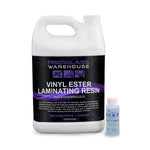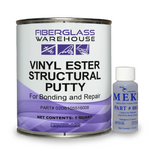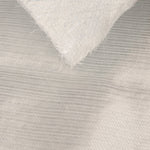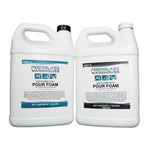You have no items in your shopping cart.
Fiberglass fillers are commonly used in DIY projects and repairs. These fillers typically come in the form of a powder or strand. It is mixed with resin to provide additional strength, stiffness or to create different consistencies and thickness. Whether you want to repair a damaged surface, bond fiberglass surfaces together, create a mold or add some body to a surface, fiberglass fillers can help you achieve your goals. However, not all fiberglass fillers are created equal, and not all of them are suitable for every project. Fillers can reduce or increase weight, improve sanding properties, add strength and act as an adhesive or putty. In this blog post, we'll explore the common uses for fiberglass fillers, different types of fiberglass fillers available on the market, their characteristics, and their uses.
Fiberglass fillers with resin can be used for a variety of DIY projects such as:
- Repairing boats, cars, or other fiberglass surfaces that have been damaged by impact, weathering, or wear and tear.
- Filling in gaps or holes on a fiberglass surface.
Types of Fiberglass Fillers
There are several types of fiberglass fillers that you can choose from, depending on the project you have in mind. You can use just one or mix several together to get your desired outcome. Some of the most common fillers include:

- Milled Fibers: These are glass filaments that are milled to a specific density and come in a variety of lengths. They can be mixed with resin to create a thick, paste-like consistency. Milled fibers are ideal for repairing holes, gouges, cracks, and gaps in surfaces, as they provide excellent structural support and reinforcement. It adds strength and dimensional stability as well as increasing impact resistance and surface hardness.

- Microsphere/ glass bubbles: These are tiny hollow spheres that can be mixed with resin to create a lightweight, sandable mixture. Microsphere fillers are often used for fairing, filling in minor imperfections, such as dents, scratches, and pinholes, and to create a smooth surface for finishing. It is often mixed with other fillers to help them sand better as well. It is not recommended for large holes and gouges.

- Fumed silica: This is a powdered filler also known as Cabosil or Aerosil that can be mixed with resin as a thickening agent. Fumed silica filler is ideal as an adhesive, filling gaps, filets and for preventing sagging or run off on vertical surfaces. It is difficult to sand. If you need to sand your repair, it is recommended to add a filler such as glass bubbles to make sanding easier.
Mixing Fiberglass Fillers with Resin
Mixing fiberglass fillers with resin requires a bit of practice and patience, as the ratio and consistency of the two materials must be precise for optimal results. If you are mixing several batches, make sure to write down the amount of fillers added to the resin on the first batch so you can repeat it for each subsequent batch. Here's how to mix fiberglass fillers with resin:
-First off, it is important to use the proper safety equipment. You will want to use gloves and a dust mask or respirator. Most fillers get into the air easily and you don’t want to breathe them in. Goggles or some sort of eye protection is also recommended. Make sure to work in a well-ventilated area.
- Determine the amount of fiberglass filler you'll need for your project. The amount will depend on the size, type, and thickness of the repair or work you are working on. If your repair is on a horizontal surface, you may get away with a thinner consistency than if you are working on a vertical surface.
- Measure the resin and fiberglass filler according to the consistency you need. There are several different consistencies you may have heard during your research. There is a ketchup consistency, mayonnaise consistency and peanut butter consistency. There are different reasons you would want each of these consistencies. The thicker the resin and filler, the more filler that is needed.

A ketchup consistency is a bit runny and is not ideal for vertical surfaces. It is great as an adhesive on horizontal surfaces or for laminating.

A mayonnaise consistency is thicker and can be used on vertical surfaces but it will sag a little bit. It is great as an adhesive and for fairing and filleting.

A peanut butter consistency is good for vertical surfaces as it will not sag and can be used for filling holes, filleting and bonding.
A very thin consistency can also be mixed for laminating and coating.
- Once you have figured out the consistency needed and the amount of filler that will be added, mix the two materials thoroughly, until the resin and fillers are uniform. Next, add the MEKP catalyst.
-Use a stir stick or a mixing tool to get rid of any lumps or bubbles
- Apply the mixed fiberglass filler to the surface, using a putty knife or a trowel. Smooth out the surface until it's even and level. Allow the filler to cure according to the manufacturer's instructions.
-Sand and smooth the area once cured for a clean finish.
Conclusion
By choosing the right type of fiberglass filler for your project and mixing it with resin correctly, you can achieve professional-looking results that are durable, long-lasting, and affordable. However, it's important to follow the manufacturer's instructions carefully, wear protective gear, and work in a well-ventilated area, as fiberglass fillers with resin can be hazardous if mishandled. With a bit of practice and patience, you can become a master and repairing fiberglass surfaces!
Still have questions? You can email us at sales@fiberglasswarehouse.com or call us at 833-669-7899 for more information. We are always happy to help.









